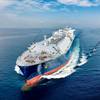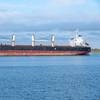The Panama Canal will be run as a competitive business for the benefit of the Panamanian people after it reverts to national control at year's end, the waterway's administrator said. "The Canal was run before on a break-even concept, like a public utility," Panama Canal Commission (PCC) administrator Alberto Aleman Zubieta told a lunch for members of the American Chamber of Commerce. "But it will be run on the corporate concept of profitability ... for the 2.7 million Panamanians who will be its owners." Panama will become owner and operator of the canal at noon on Dec. 31, when the U.S. hands over the waterway as agreed in a 1977 treaty. To ensure its competitiveness into the 21st century, $1 billion is being spent on overhauling the 50 mile (80 km) waterway, Zubieta said, adding that the improvements will raise the canal's operating capacity by 20 percent.
The centerpiece of the overhaul, a $232 million program to widen the canal's narrowest point - the nine-mile (14 km) long Gaillard Cut - to 630 ft. (192 m) from 500 ft. (152 m), will be completed in 2002, 10 years ahead of schedule.
The upgrade will allow 24-hour navigation by Panamax vessels - ships built to the maximum specifications of the waterway's 1,000 ft (310-m) by 110 ft (34-m) locks - in both directions, he said.
A further $180 million investment in new towing locomotives and track at the waterway's three sets of locks, together with a $33 million investment in new tugboats, will raise the number of daily ship transits to a "sustainable maximum" of 42, up from the current 37. The recently installed Enhanced Vessel Tracking Management System (EVTMS), which provides real-time locations for every vessel in the canal, would increase safety for canal users into the next century, Zubieta said.
Zubieta expressed confidence in the canal's Panamanian "highly trained" workforce, which will take over full running of the waterway at noon on Dec. 31. At the start of October, Panamanians comprised 97 percent of the canal's 9,000 employees, he said, up four percent in 1998.
One of the challenges that the new administration faces will be to take care of the canal's watershed, Zubieta said. The rainforest-covered basin, which supplies the canal with the water vital to its operation, has been protected from logging and settler encroachment by the U.S. military control of the Canal Zone - a 10-mile (16 km) security strip running the length of the canal - since it opened in 1914.
The PCC is scheduled to meet for the last time in its 85- year history in Washington from Oct. 13 to 15 to present accounts for fiscal 1999, the last complete financial year under U.S. control. The Panama Canal Authority, as the administration will be called under Panamanian control, will take control at year's end. During 1998, more than 13,000 ships passed through the canal, generating $545 million in revenue.
Subscribe for
Maritime Reporter E-News
Maritime Reporter E-News is the maritime industry's largest circulation and most authoritative ENews Service, delivered to your Email five times per week










